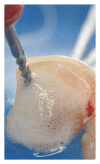Photodynamic therapy in pediatric dentistry
- PMID: 25371829
- PMCID: PMC4202263
- DOI: 10.1155/2014/217172
Photodynamic therapy in pediatric dentistry
Abstract
Conservation of deciduous teeth with pulp alterations caused by caries and trauma is a major therapeutic challenge in pediatric dentistry as a result of the internal anatomy and life cycle characteristic. It is essential that the root canal procedures sanitizers have a performance in eliminating bacterial. In this context, antimicrobial photodynamic therapy (PAT) is promising and emerging as adjuvant therapy in an attempt to eliminate the microorganisms persistent to chemi-mechanical preparation. Since there is presence of oxygen in cells, photosensitizer activated by light can react with molecules in its vicinity by electrons' or hydrogen's transfer, leading to microorganism death. This paper reports the case of 4-year-old patient, female, with early childhood caries. The proposed endodontic treatment incuded chemomechanical treatment allied to PAT in the decontamination of root canals using methylene blue dye 50 μg/mL during 3-5 minutes and 40 J/cm(2) as energy density, taking into account the need for tissue penetration and effectiveness of PAT inside the dentinal tubules.
Figures














References
-
- McDonald R, Avery DR, Dean JA. Dentistry for the Child and Adolescent. 9th edition. Philadelphia, Pa, USA: Mosby; 2010.
-
- Cameron AC, Widmer RP. Handbook of Pediatric Dentistry. 3rd edition. Philadelphia, Pa, USA: Mosby; 2003.
-
- Bastone EB, Freer TJ, McNamara JR. Epidemiology of dental trauma: a review of the literature. Australian Dental Journal. 2000;45(1):2–9. - PubMed
-
- Pazelli LC, Freitas ACD, Ito IY, Souza-Gugelmin MCMD, Medeiros AS, Nelson-Filho P. Prevalence of microorganisms in root canals of human deciduous teeth with necrotic pulp and chronic periapical lesions. Pesquisa Odontologica Brasileira. 2003;17(4):367–371. - PubMed
LinkOut - more resources
Full Text Sources
Other Literature Sources

